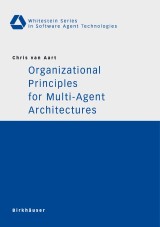Details

Organizational Principles for Multi-Agent Architectures
Whitestein Series in Software Agent Technologies and Autonomic Computing
|
53,49 € |
|
| Verlag: | Birkhäuser |
| Format: | |
| Veröffentl.: | 30.03.2006 |
| ISBN/EAN: | 9783764373184 |
| Sprache: | englisch |
| Anzahl Seiten: | 213 |
Dieses eBook enthält ein Wasserzeichen.
Beschreibungen
1. 1 Background In this work, we develop a framework for the design of multi-agent systems inspired by (human) organizational principles. Organizations are complex entities formed to ov- come various limitations of individual agencies, such as cognitive, physical, temporal and institutional limitations. There is a parallel between the complexity of organizations and multi-agent systems. Therefore, we explore the use of concepts, methods and techniques from human organizational design as architectural principles for multi-agent systems. Three research lines are presented: organizational modeling and coordination, interop- ability and agent models. Organizational modeling and coordination are concerned with how resources (i. e. agents) can be identi?ed and related to each other. In order to have agents cooperate, several issues of interoperability have to be addressed. Agent models deal with the design of individual intelligent software agents, taking into account typical features of agent intelligence. Every (human) activity raises two challenges: division of labor and coordi- tion [Mintzberg, 1993]. Division of labor is the decomposition of work (or goals) into various distinct tasks. Coordination refers to managing relations between these tasks to carry out the work. The patterns of division of labor, responsibilities (people who do the work), clustering of responsibilities into units and coordination between units can be de?ned by organizational structures [Galbraith, 1973]. The design of an organization should cover how one or more actors are engaged in one or more tasks, where knowledge, capabilities and resources are distributed.
Agent Organization Framework.- Coordination Strategies for Multi-Agent Systems.- Five Capabilities Model.- Interoperation within a Complex Multi-Agent Architecture.- Message Content Ontologies.- Conclusions.
Introduction of several human organizational principles into multi-agent architecture Use of industry-strength business cases in the logistics and insurance domain Multi-disciplinary research, taking into account multi-agent organizations, coordination mechanisms, agent models and message content ontologies
<P>The general question addressed in this book "How can human organizational principles be used for multi-agent architectures?" is answered by an exploration of the possibilities to design multi-agent systems as artificial organizations.<BR><BR>Key topics of this book:<BR><BR>Framework for multi-agent system design, based on human organizational notions and principles for distributed intelligent systems design<BR><BR>"Coordination mechanisms" in the form of "Problem Solving Methods"<BR><BR>Multi-agent architecture capable of (semi)automatic reuse of Problem Solving Methods (PSMs)<BR><BR>"ontology-based communication"</P>
Diese Produkte könnten Sie auch interessieren:

Praxisbuch ISO/IEC 27001
von: Michael Brenner, Nils gentschen Felde, Wolfgang Hommel, Stefan Metzger, Helmut Reiser, Thomas Schaaf
Preis: 69,99 €

Praxisbuch ISO/IEC 27001
von: Michael Brenner, Nils gentschen Felde, Wolfgang Hommel, Stefan Metzger, Helmut Reiser, Thomas Schaaf
Preis: 69,99 €

Cybersecurity in the Transportation Industry
von: Imdad Ali Shah, Noor Zaman Jhanjhi
Preis: 168,99 €
-
-
© 2024 media control GmbH
Alle Preise enthalten die gesetzliche Mehrwertsteuer. - AGB
- Impressum
- Datenschutzerklärung
- Kontakt
- FAQ
- Mein Konto
- Home
- Erweiterte Suche
- Widerrufsrecht
- Reader-Software
- Desktop-Ansicht
- Gutschein-Code einlösen